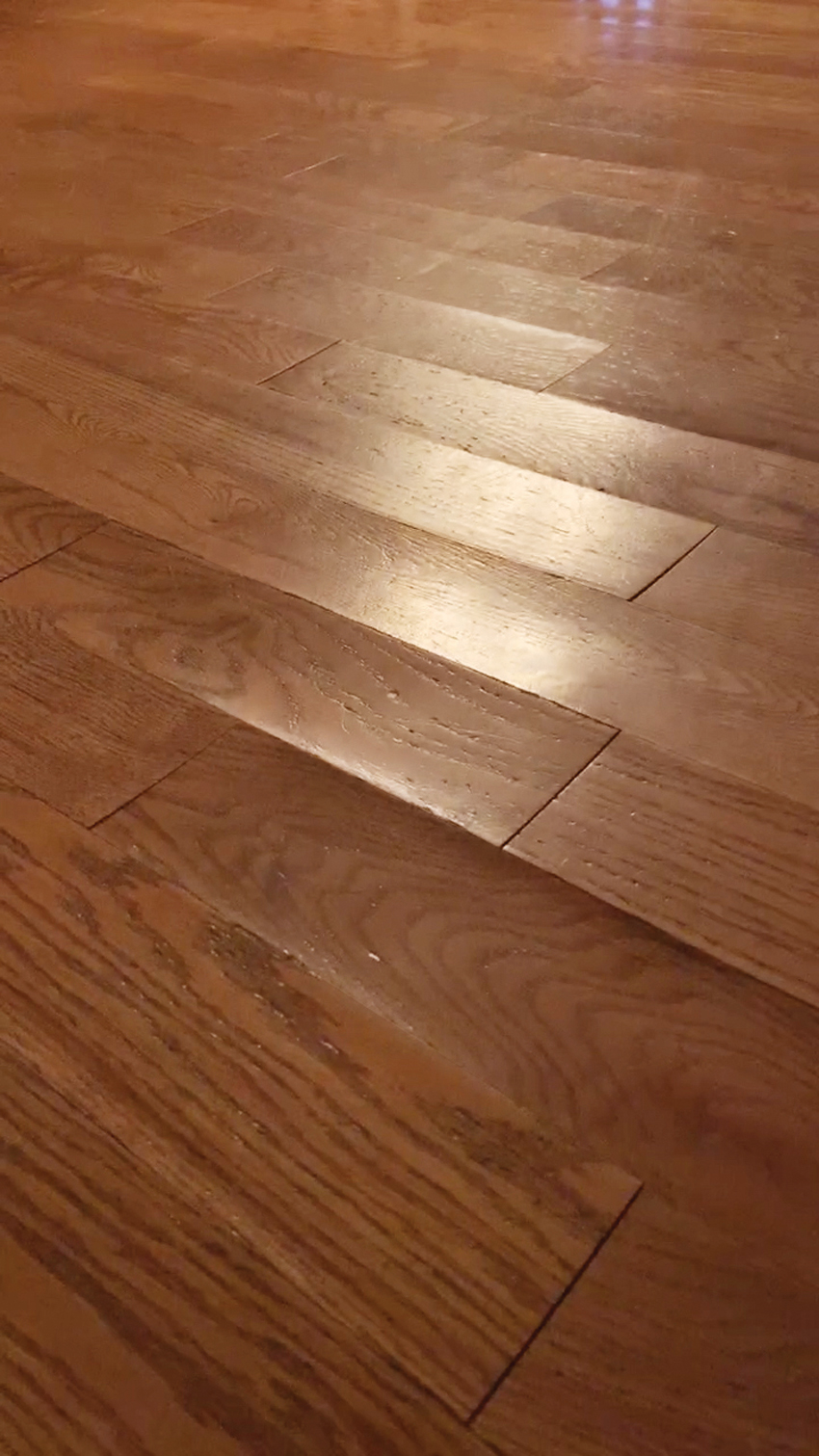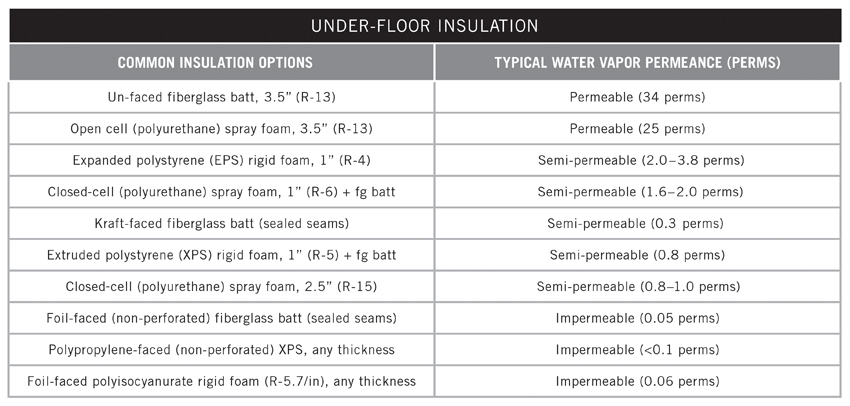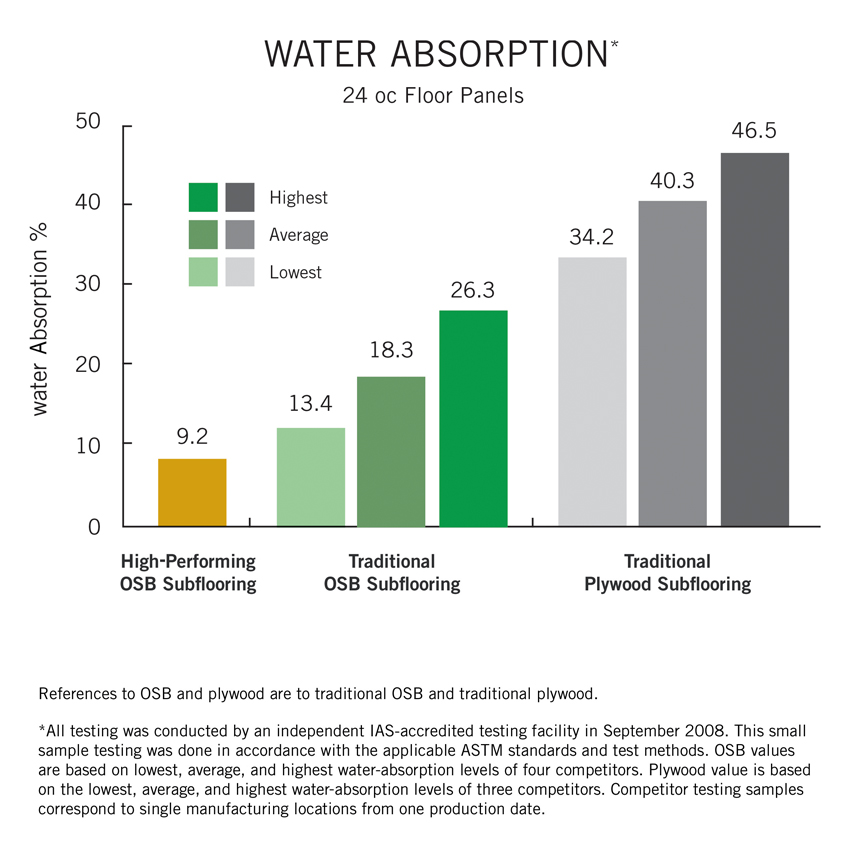The Building Science of Floor Systems
The Role of Flooring
With an understanding of the relevant requirements and options for the crawl space itself, we now turn our attention to the flooring assembly above it. The common construction is to use wood floor joists (i.e., dimensioned lumber, engineered wood joists, floor trusses, etc.) to span the distances between the perimeter of the crawl space and any intermediary piers or supports. On top of this are placed panels of plywood or engineered wood that is glued and nailed per generally accepted standards. Then the final layer is placed in the form of finish flooring of whatever type is selected. Underneath, insulation is added between the joists if it is a vented crawl space, or the space is left open if it is an unvented crawl space.
This approach to floor assembly construction over a space below has been in use for generations and is fairly common. The issue we are concerned about here is the way that moisture and temperature operate in these assemblies. The fundamental physics of the situation is that the floor assembly creates a barrier between the space above and the space below. When the temperature and humidity levels are different on the two sides, nature will do what it always does: seek to equalize the differences. Heat always flows toward colder areas, and air with more humidity spreads into dryer air. The wood portions of the assembly will allow both heat and humidity to transfer based on the physical properties of the wood used. We use insulation to further interrupt or slow the transfer of heat to keep buildings more comfortable and use less heating/cooling energy in the process. Humidity or vapor transfer is restricted either intentionally or accidentally also by the materials that are used in the assembly.


Images courtesy of Huber Engineered Woods, LLC
Different types of flooring will react to moisture in different ways and will have different rates of permeability. Improper moisture management can show up as floor problems, but the real issue is below.
When vapor moves by itself through a material, this is referred to as “vapor drive,” which is not necessarily induced by the air but rather the materials. So if moisture is trapped next to or inside a material (like wood), it is vapor drive that will move it outward, allowing the material to dry out. The determination of how much vapor will transfer into or through a material, and at what rate, is the permeability (perm rate) of the materials used. We have already noted that wood is porous and fairly permeable, such that floor joists can allow for moisture to pass through. Wood subflooring is made from wood, but the glues and resins used in some engineered wood panels reduce its permeability, which can be a good thing. In fact, within the wood subflooring sector, there are ranges of quality that are simply referred to as good, better, and best. The permeability of the subflooring tends to decrease as the quality increases, thus helping to restrict vapor drive. Insulation comes in different types and can range from impermeable (i.e., closed-cell spray foam) to very permeable (i.e., fiberglass batts) and places in between, all depending on the material selected. Finally, the finish flooring can range widely based on materials used. For example, carpet and hardwood flooring are very permeable. On the other hand, many resilient floorings, including the increasingly popular LVT and LVP, are quite impermeable, meaning that they do not allow much if any vapor or moisture to pass through them.

Image courtesy of Huber Engineered Woods, LLC
Different types of insulation have different perm ratings indicating their vapor permeance.
The goal in successful floor assembly design is to allow for the opportunity for the floor assembly to dry out if vapor or moisture does get into it. In the days when no insulation was used in the floors and the assembly was primarily wood, this was pretty easy, as any moisture or vapor passed easily through to either side of the assembly. Building science now requires us to design for the drying potential of assemblies to avoid creating a condition that will prevent proper drying. In the case of floors over a vented crawl space, the general recommended strategy is to increase the permeability from the bottom up to allow drying to occur toward the interior if needed. The assumption here is that a vented crawl space is being used that has little drying potential toward the ground.
The design and construction issue for floor assemblies over crawl spaces then becomes how to achieve a vapor drive through the assembly upward into the interior. The answer lies in the selection of the materials used. If permeable flooring is used, (i.e., carpet, hardwood), the permeability of the insulation and subflooring is less critical since the flooring will allow drying toward the interior. However, if impermeable flooring is used, (i.e., LVT, LVP, or other non-permeable resilient flooring), the permeability of the insulation and subflooring is critical. In these cases, it may be necessary to look at ways to reverse the vapor drive to the under-floor space or prevent it from entering altogether. In this latter case, it is important to pay attention to the details of all the materials. It is not advisable to create a “double barrier” that has both a top layer (flooring) and a bottom layer (insulation) that can trap moisture between them because they are both impermeable.
Subfloor Options
One of the key differences in flooring assemblies that plays directly into everything we have discussed thus far is the selection of the subflooring material. While individual boards were commonly used before World War II, plywood became the subflooring of choice in the mid-20th century. The American Plywood Association (APA), now known as the Engineered Wood Association, developed testing for subflooring panels known as PS-1 and PS-2 criteria for the structural performance of the plywood and the floor joists acting together as a system. In the 21st century, engineered wood is the more common alternative to plywood, which typically means a type of oriented strand board (OSB). When used for subfloor panels, it still must demonstrate, through third-party verification, the structural performance required by PS-2 testing, which has been updated through the U.S. Department of Commerce (DOC).
Both plywood and OSB subflooring come in different grades, essentially rated good, better, and best. The best category is also referred to as high-performance subflooring and brings some desirable characteristics related to the factors we have been discussing. High-performance OSB subflooring has been tested and compared to other products. It has been shown to outperform commodity OSB (good grade) and most plywood in terms of moisture absorption and vapor permeability. This is good new because it means there is less likelihood of deterioration and mold growth if the high-performance OSB does get “wet” from moisture or vapor. It also means that its permeability needs to be factored into the assembly for drying potential. It is worth noting that some LVT and LVP manufacturers recommend using a better-quality OSB if not high-performance OSB to help ensure long-term performance of their finished flooring material. Because of its impermeable nature, the use of LVT and LVP means that the drying potential to the interior is limited. To ensure that a high-performance OSB or engineered wood panel is used, one suggestion is to specify a product that has been reviewed by the International Code Council Evaluation Services. One such reviewed panel was the first engineered wood product introduced to the market to receive such an evaluation that documents higher-performance design values over PS-2 requirements.

Image courtesy of Huber Engineered Woods, LLC
One high-performance engineered wood subflooring has documented greater resistance against moisture absorption than other types of OSB and plywood panels.
When other, more permeable flooring options are used, a high-performance engineered wood product can also be an ideal choice. It has been tested to show that it can resist absorption and deterioration better than the traditional alternatives and can be consistent with the pattern of drying to the interior since the flooring will be more permeable than the subfloor. The high-performance engineered wood product may also be more permeable than the insulation, which will help maintain the proper vapor drive to ensure drying to the inside.
Best Practices and Solutions
The variety of interrelated issues and the options for construction that we have reviewed have been studied by building scientists for some time. In particular, the well-known Building Science Corporation (BSC) cofounded by the engineer Joseph Lstiburek has investigated this issue in some depth and published a number of articles and other free documents available at www.buildingscience.com/documents. Some of the recommendations are included in our review of best practices for crawl spaces outlined as follows.









